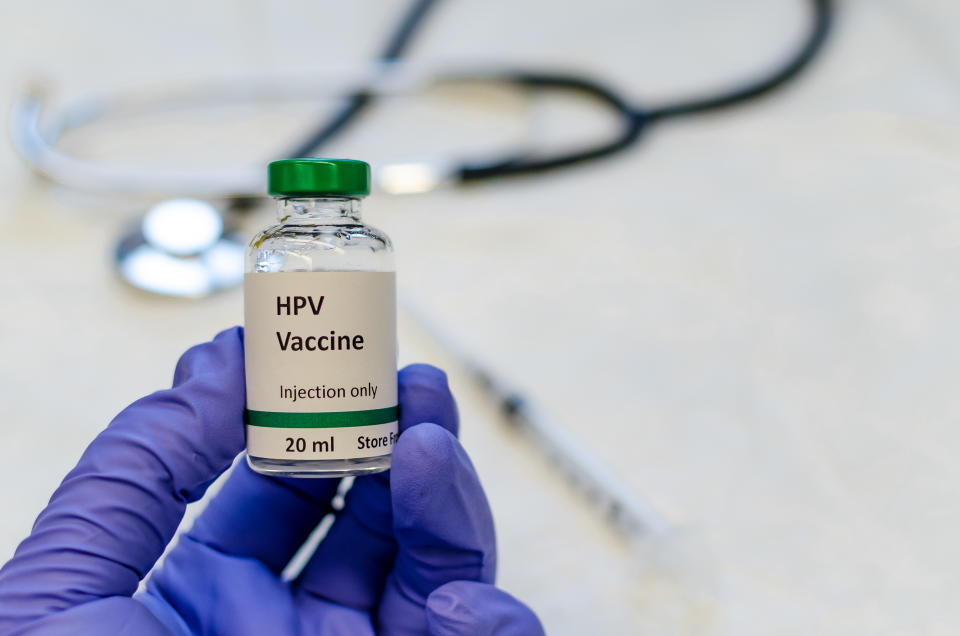Just one HPV jab may protect against cervical cancer

A single human papillomavirus (HPV) vaccine may be enough to protect against cervical cancer, research suggests.
At some point in their life, four in five people catch the sexually-transmitted virus, which is behind 99.7% of cervical-cancer cases.
The NHS offers the first of two jabs against HPV to boys and girls aged 12-to-13.
It typically gives the second dose between six and 12 months later, claiming both are “important” for “protection”.
Read more: One in 10 women think the HPV virus is 'dirty'
A study by The University of Texas in Galveston suggests, however, a single jab is as effective as multiple vaccines at preventing “pre-invasive cervical disease”.
Around 3,100 women develop cervical cancer every year in the UK.
In the US, 13,800 new cases are expected to be diagnosed in 2020.
The US Centers for Disease Control and Prevention recommends boys and girls under 15 receive two HPV vaccine doses.
To uncover whether both are necessary, the scientists looked at more than 133,000 females aged between nine and 26.
Half had not been vaccinated, while the others received Gardasil jabs.
This protect against four strains of HPV - six, 11, 16 and 18.
Types 16 and 18 cause more than 70% of cervical cancers in the UK, while strains six and 11 are behind around 90% of genital warts.
One year after the vaccines - or lack of - the women had a smear test to uncover any pre-cancerous cervical changes.
Results - published in the journal Cancer - revealed that among the 15-to-19 years old who had one, two or even three HPV doses, rates of pre-invasive cervical disease were lower than in those not immunised.
People who start getting vaccinated against HPV after 15 require three doses due to them not responding as well to just two jabs as younger people.
Within five years, 2.65% of the unvaccinated 15-to-19 year olds developed pre-invasive cervical disease, compared to 1.62% who had one jab, 1.99% who had two and 1.86% who had three.
Pre-invasive cervical disease is generally defined as alterations to the cervix that are not yet cancerous, like abnormal cell changes or genital warts.
The risk of the condition was 36%, 28% and 34% lower among those who received one, two or three doses of the HPV vaccine, respectively.
Among those under 15 and over 20, the scientists found no significant differences in pre-disease risk between those having one, two or three jabs.
Read more: DIY smear tests could be a 'game changer'
“This study shows the impact of vaccinating at younger ages and its lasting long-term protection against cervical cancer,” said lead author Dr Ana Rodriguez.
“It is important to educate parents about the need to vaccinate their children.”
Writing in an accompanying editorial, scientists from the University of Melbourne added: “If one dose of HPV vaccine was sufficient for effective protection, HPV vaccine implementation and scale-up would require less logistics...available doses could extend further and the overall cost would be lower”.
Another expert welcomed the results, but urged women to “stick to the two dose schedule” for now.
“Standard regimens have already been reduced from three to two doses and it may be possible to reduce further to one dose if additional evidence comes through supporting this change,” said Professor Adam Finn, from the University of Bristol.
“Given the limited available supplies of vaccine globally and the urgent need to protect girls and young women worldwide against this, the second biggest cancer killer in females after breast cancer - this would be a very positive development.
“We are all eagerly waiting for more information on this and the latest study reported here adds further encouragement.
“For the moment, though, the best advice is to stick to the recommended two dose schedule to ensure optimal protection.”

How is cervical cancer detected?
Women in England and Wales are tested for high-risk HPV strains during their smear test, with Scotland and Northern Ireland following suit “in the future”.
Those carrying the virus then have their cell sample analysed to uncover any changes that may lead to cancer.
Smears have traditionally looked for cell changes, however, testing for the virus is said to be more accurate, preventing almost 500 “extra” cases of cervical cancer a year.
Women aged between 25 and 64 who are registered with a GP in the UK are invited for a smear every few years.
Around a quarter fail to attend, with uptake at its lowest in England for 19 years.
After the screening, women should get the results within two weeks.
Read more: Urine test could mark the end of smear tests
If abnormal, a woman may be invited for a colposcopy, which looks closer at the cervix.
Some may also have a biopsy of their cervical tissue.
Abnormalities on the cervix’s surface are usually removed via a thin wire loop with an electrical current.
The area is sent for tests to determine the extent of the abnormalities.
If cell changes are higher up, a thin straight wire is used.
If abnormal cells remain, lasers or heat may “burn” away the affected tissue.
Nine in 10 women do not have abnormal cell changes again after the above treatments.



